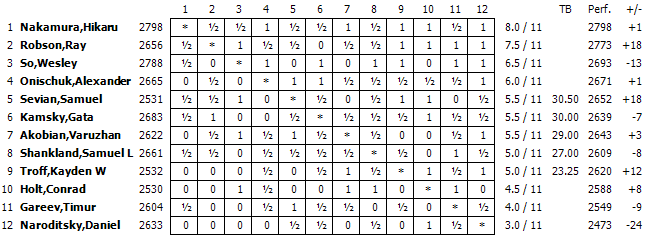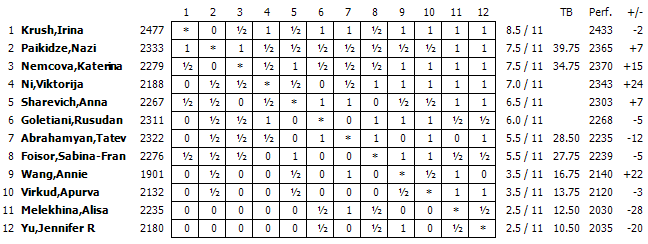



After the second round, two Americans grabbed their spots among the top five in the world on the unofficial live rating list. Nakamura moved to Number 2, jumping over the 2800 rating barrier, and Wesley So, 21, moved to number five. But the race between the two strongest players didn't materialize.

Unexpectedly, So lost three games and was forfeited in round nine after six moves. He wrote "double check triple check use your time" on a piece of paper, his opponent Varuzhan Akobian complained to the referee and So lost the game, apparently according to the rules. Six moves and seven words threatened to become the highlight of an otherwise marvelously organized championship.
But fighting chess prevailed. So came back in the next round, defeating the defending champion Gata Kamsky, 40, but by then the first place was out of his reach. Eventually, Nakamura showed his class and outraced the dangerous Ray Robson, 20. The champion took home $40,000 from the total of $175,000 prize money.

The former Czech women's champion Katerina Nemcová had a rocket start with six points in the first seven games, building a one point lead. Her finish, three draws and one loss, opened the door for Krush. The defending champion took advantage and cruised to overall victory by holding Nemcová to a draw in the last round. Krush collected $20,000 for her effort.


Nemcová is slowly returning to a form that made her one of the world's leading junior players in the past. Sharing second place with Nazi Paikidze, 21, is a good start on the way up.
The Championships were a mixture of world-class players, seasoned veterans, aspiring newcomers and young talents. The sturdy chess technicians Kamsky and Alex Onischuk, 39, probably have their best years behind them, but many young players can profit from their experience. Jennifer Yu, 12, was the youngest woman and hopefully is not going to be discouraged by her result. Samuel Sevian, 14, the youngest grandmaster, has a bright future ahead of him.
In her comeback, Krush used a positional exchange sacrifice twice. It became a trademark of modern chess that begun in 1946 during the match Prague - Moscow. Facing two Czech masters, Ludek Pachman and Frantisek Zita, David Bronstein pushed his a-pawn, opened the a-file and sacrificed his rook for a bishop. Those two games were Bronstein's visit card, perhaps even better known than his world championship match against Mikhal Botvinnik, tied 12:12. The modern era of pawn and exchange sacrifices, unbalanced positions and opening preparation started right there.
The positional exchange sacrifice appearing in the late 1930s in a tricky variation of the Grunfeld Indian defense was contested in Saint Louis by two young players, the U.S. Open champion Conrad Holt, 21, and U.S. Junior champion Kayden Troff, 16. Their play is still marked by spinning and slipping all over the place. Never mind that the variation is not completely correct for Black, Holt had a task to refute it. He managed to get an advantage, but soon misplayed it and Troff equalized. The see-saw battle continued with mistakes until in a winning position Holt walked into decisive mating threats. A heroic fight!

[Event "ch-USA, Saint Louis "] [Site "?"] [Date "2015.??.??"] [Round "?"] [White "Holt, Conrad"] [Black "Troff, Kayden W"] [Result "0-1"] [ECO "D83"] [WhiteElo "2530"] [BlackElo "2532"] [Annotator "GM Lubomir Kavalek/The Huffington Post"] [PlyCount "96"] [EventDate "2015.??.??"] 1. d4 Nf6 2. c4 g6 3. Nc3 d5 4. Bf4 Bg7 5. e3 O-O ({Garry Kasparov, having just turned 52, advocated} 5... c5 6. dxc5 Qa5 {during his playing days.}) 6. Rc1 c5 7. dxc5 Qa5 8. cxd5 Rd8 {When the position appeared in the game Capablanca - Reshevsky, AVRO 1938, the American grandmaster spent 58 to Capa's two minutes. The game was drawn in 42 moves, allowing Reshevsky to celebrate his 27th birthday.} 9. Bc4 ({In the game Tolush-Botvinnik, Leningrad 1939, White tried to trick his opponent with} 9. Qd2 $6 Nxd5 10. Bc7 $6 {A virtual fork!} Qxc7 11. Nxd5 Rxd5 $1 {The exchange sacrifice refutes the diabolical trap.} 12. Qxd5 Be6 13. Qd2 Nc6 14. Rd1 Rd8 15. Qc1 Qa5+ 16. Rd2 Rd5 {and Black won the c-pawn with decisive advantage.}) 9... Be6 (9... Qxc5 10. Bb3 { favors White. The black Queen is uncomfortable.}) 10. e4 {Arturo Pomar's idea, giving up the e-pawn and keeping the strong d-pawn.} ({Nearly 75 years ago, it was fashionable to deflect the black queen with 10.b4, until a cure in the form of the exchange sacrifice was found:} 10. b4 Qxb4 11. Qb3 Qxb3 12. Bxb3 Nxd5 $5 13. Nxd5 Rxd5 $1 {A different version of the same exchange sacrifice.} (13... Bxd5 $2 {loses to} 14. Rd1 {.}) 14. Bxd5 Bxd5 15. Nf3 Nc6 16. O-O Bxa2 { with a compensation for the exchange, Podgorny-Prucha, Prague 1943}) 10... Nxe4 11. Nge2 Nxf2 {The best of many inadequate choices.} ({The inaugurate game went:} 11... Nxc5 12. O-O Bd7 13. Bg5 b5 14. Bd3 b4 15. Ne4 Nxd3 16. Qxd3 Bb5 17. Qf3 f6 18. d6 Bxe2 19. Qxe2 fxg5 20. dxe7 Re8 21. Nd6 {1-0 (21) Pomar Salamanca,A-Tatai,S Malaga 1969}) 12. Qa4 $1 ({Not} 12. Kxf2 $2 Qxc5+ 13. Be3 Qxc4 $17) 12... Qxc5 ({After} 12... Qxa4 13. Nxa4 Nxh1 14. dxe6 f5 15. Kf1 Nc6 16. Kg1 {and White picks up the knight on h1 with an edge.}) 13. dxe6 Nxh1 14. exf7+ Kf8 {All White needs is to land one of his knights on the square e6.} 15. Ne4 Qb6 16. Bc7 $5 {This Tolush-like move should win.} (16. Qa3 $1 {is even stronger threatening to bring one of the knights to e6 ( Ne4-c5-e6 or 17.Be3 and 18.Nf4. For example} Na6 17. Be3 Qxb2 (17... Qb4+ 18. Qxb4 Nxb4 19. Nf4) 18. Ng5 $1 {wins.}) 16... Qe3 {Finally, Troff plays a novelty, but it should still lose.} ({Accepting the bishop did not turn out to be good:} 16... Qxc7 17. Ng5 Qxh2 18. Ne6+ Kxf7 19. Nxd8+ Kf6 (19... Kf8 20. Ne6+ Kf7 21. Ng5+ Kf8 22. Qb5 Qh4+ 23. g3 Nxg3 24. Ne6+ Kf7 25. Nc7+ {and White mates soon.}) 20. Qe8 Qh4+ 21. g3 Nxg3 22. Qf7+ Kg5 23. Ne6+ Kh5 24. Qf3+ Kh6 25. Nxg3 Nc6 26. Ke2 Qh2+ 27. Qf2 Nd4+ 28. Kd3 {1-0 (28) Estevez Morales,G (2345)-Beggi,P (2200) Reggio Emilia 1974}) 17. Bxd8 Nc6 18. Bxe7+ Nxe7 19. Be6 $2 {This runs into an unpleasant deflection, losing the big advantage.} (19. Qc2 {keeps the pressure on. Black's knight on h1 has problems.}) 19... b5 $1 {This deflection equalizes the game.} 20. Qc2 (20. Qxb5 Qxe4 $19) 20... Nf2 21. Nc5 Rd8 (21... Bd4 $11 {was another good choice.}) 22. Qb3 (22. Bb3 Rd6 23. Nd7+ Rxd7 24. Qc8+ Nxc8 25. Rxc8+ Ke7 26. Re8+ Kf6 27. Rxe3 Nd3+ 28. Kf1 Nc5 $11) 22... Nd3+ $6 { A slight slip.} ({The fireworks after} 22... Bd4 23. Nd7+ Rxd7 24. Qxe3 (24. Bxd7 $2 Nd3+ 25. Kd1 Qxe2+ 26. Kxe2 Nxc1+ 27. Kf3 Nxb3 $18) 24... Bxe3 25. Bxd7 Nd3+ 26. Kd1 Bxc1 $11 {lead to equal chances.}) 23. Nxd3 Rxd3 $6 (23... Qxd3 24. Qxd3 Rxd3 25. Rc7 Bxb2 26. Rxa7 Nc6 {was a better alternative.}) 24. Qxb5 $16 {It is more difficult for Black now.} Qd2+ 25. Kf1 Rd8 26. Bb3 Qxb2 27. Qa5 Qf6+ 28. Ke1 (28. Kg1 Qb6+ 29. Qxb6 axb6 30. Nf4 $16) 28... Rb8 {This move leaves White with two pawns up.} (28... Qb6 29. Qxb6 axb6 30. Nf4 Rb8 {is a complicated way to stay in the game, but it had to be tried.}) 29. Qxa7 {White should be winning.} Qd6 30. g3 Be5 31. Qc5 Qf6 32. Rd1 Rc8 33. Qb4 Kg7 34. Rd7 Kf8 35. Qd2 Nf5 36. Nf4 Bxf4 37. Qxf4 Qb6 38. Qf2 (38. g4 $1 {Not only does White attack the knight, but he also protects the pawn on h2. The checks are meaningless:} Qg1+ 39. Ke2 Qg2+ 40. Kd3 Qh3+ 41. Ke4 Qg2+ 42. Qf3 {forces the Queen exchange.}) 38... Qa5+ (38... Rc1+ 39. Ke2 Qb5+ 40. Kd2 Rc8 41. Rd3 Qc6 42. Qf3 $14) 39. Qd2 Qb6 40. Kf1 Qb5+ 41. Kg1 Qb6+ 42. Kg2 Ne3+ 43. Kh3 $2 {A shocking turnabout! White now loses.} (43. Kf3 $1 {was sufficient to win.}) 43... g5 $1 {Threatening 44...Qh6 mate.} 44. Rd6 (44. Qd6+ Qxd6 45. Rxd6 g4+ 46. Kh4 Nf5+ {wins.}) 44... g4+ 45. Kh4 Nf5+ 46. Kg5 Qxd6 47. Qb2 Nd4 48. Kxg4 Rc5 0-1
Garry Kasparov and Nigel Short played for the World Chess Championship in 1993. They are coming to Chess Club and Scholastic Center of Saint Louis, April 25-26, for an exhibition match consisting of two rapid and eight blitz games.
Images by Lennart Ootes and Austin Fuller
Original column here – Copyright Huffington Post
The Huffington Post is an American news website and aggregated blog founded by Arianna Huffington and others, featuring various news sources and columnists. The site was launched on May 9, 2005, as a commentary outlet and liberal/progressive alternative to conservative news websites. It offers coverage of politics, media, business, entertainment, living, style, the green movement, world news, and comedy. It is a top destination for news, blogs, and original content. The Huffington Post has an active community, with over over a quarter of a billion visits per month (according to Quantcast), making it the number 73 ranked web site in the world (Alexa, January 2014)..